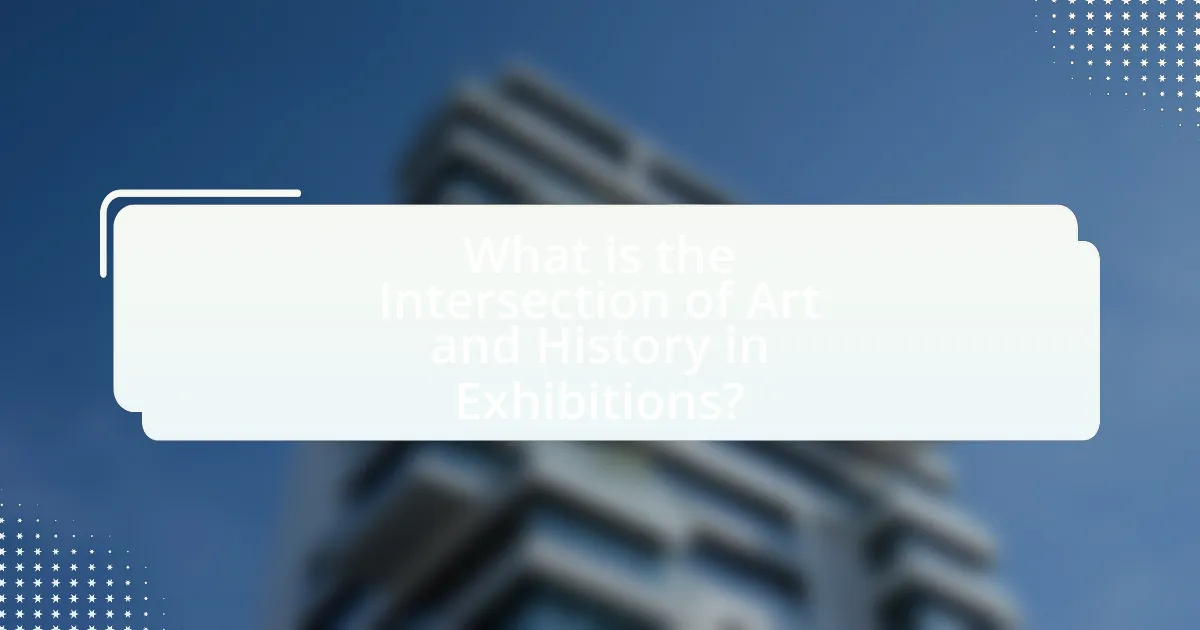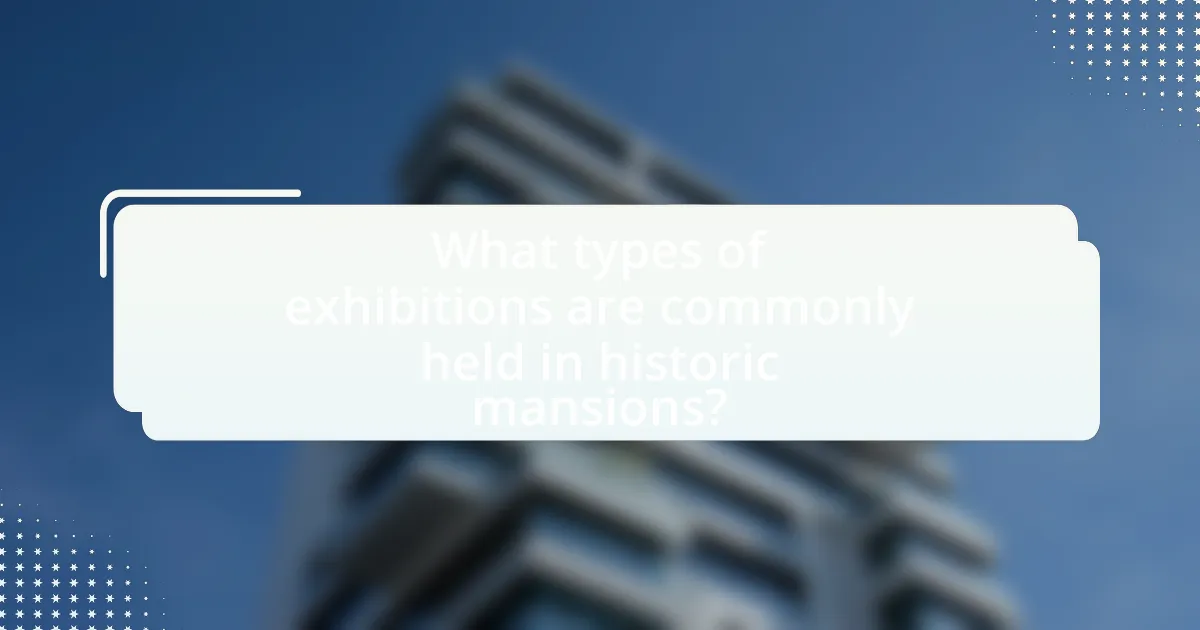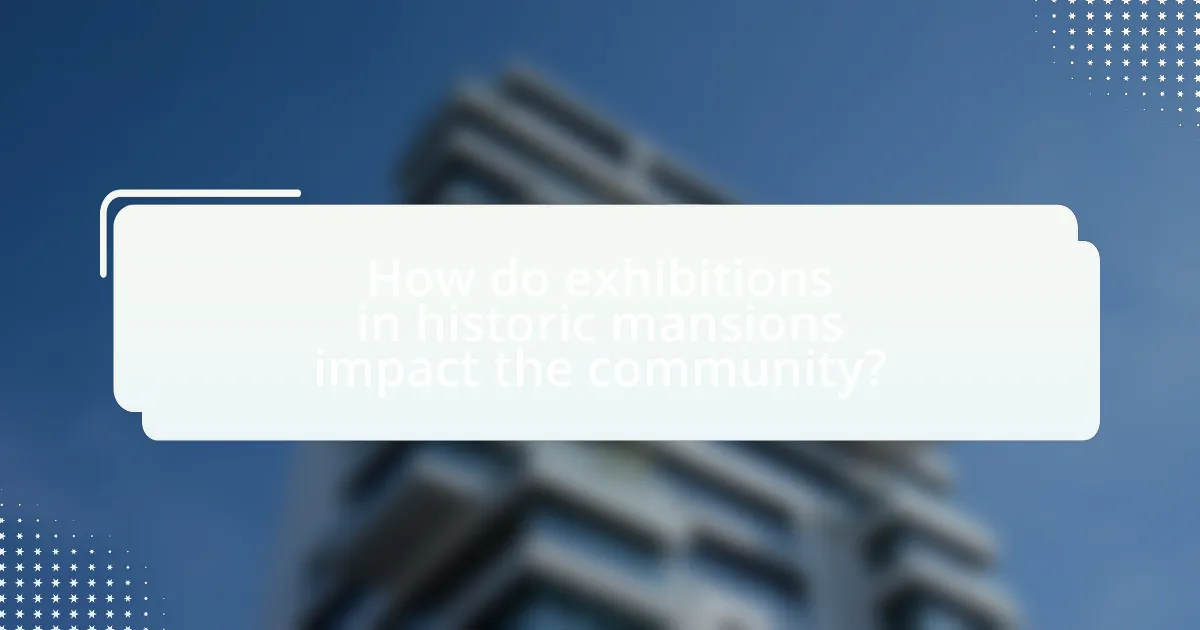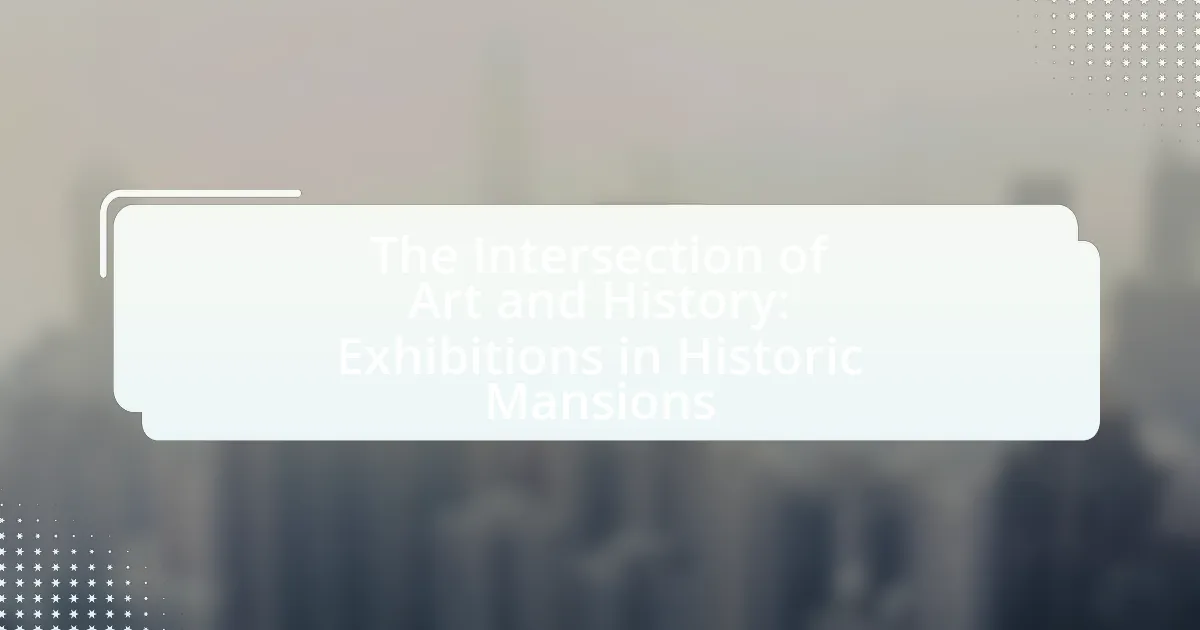The article explores the intersection of art and history through exhibitions held in historic mansions, highlighting how these venues enhance the viewer’s experience by providing contextual backgrounds that reflect the cultural narratives of specific time periods. It discusses the architectural features of mansions that complement art displays, the influence of a mansion’s history on the type of art exhibited, and the significance of combining art with historical context to foster public engagement. Additionally, the article examines the impact of temporary and permanent exhibitions on community involvement, educational opportunities, and best practices for curators in preserving the integrity of historic structures while showcasing artistic works.

What is the Intersection of Art and History in Exhibitions?
The intersection of art and history in exhibitions occurs when artistic works are displayed within historical contexts, allowing viewers to engage with both the aesthetic and cultural narratives of a specific time period. This relationship is exemplified in exhibitions held in historic mansions, where the architecture and decor reflect the era’s social and political dynamics, while the art presented often comments on or embodies those historical themes. For instance, exhibitions featuring 18th-century portraits in a Georgian mansion not only showcase the artistic styles of the time but also provide insight into the lives and values of the individuals depicted, thus enriching the viewer’s understanding of both art and history.
How do historic mansions serve as venues for art exhibitions?
Historic mansions serve as venues for art exhibitions by providing unique architectural settings that enhance the viewing experience and contextualize the artwork. The grandeur and historical significance of these properties attract visitors, creating a compelling backdrop that complements the art displayed. For instance, the Isabella Stewart Gardner Museum in Boston, housed in a historic mansion, showcases art within a setting that reflects the owner’s aesthetic vision, thereby enriching the audience’s understanding of both the art and the history of the space. Additionally, these venues often have established reputations and networks that facilitate partnerships with artists and curators, further promoting cultural engagement and preservation of heritage.
What architectural features of historic mansions enhance art displays?
Architectural features of historic mansions that enhance art displays include high ceilings, large windows, and grand staircases. High ceilings provide ample vertical space, allowing for the display of large artworks and sculptures, while large windows facilitate natural light, which enhances the visibility and appreciation of art pieces. Grand staircases often serve as focal points, creating dramatic backdrops for art installations and guiding visitors through the space. These features not only create an aesthetically pleasing environment but also contribute to the overall experience of viewing art in a historic context.
How does the history of a mansion influence the type of art exhibited?
The history of a mansion significantly influences the type of art exhibited by reflecting its architectural style, previous owners, and cultural context. For instance, a mansion built during the Renaissance period may showcase art that aligns with that era, such as classical sculptures or paintings by renowned artists of the time. Additionally, if a mansion was owned by a prominent figure in the art world, the exhibited pieces may include works that resonate with their personal collection or artistic preferences, thereby creating a narrative that connects the art to the mansion’s legacy. Historical events associated with the mansion can also dictate thematic exhibitions, such as showcasing local artists during a specific period or highlighting movements that were significant to the mansion’s community.
Why is the combination of art and history significant in exhibitions?
The combination of art and history is significant in exhibitions because it creates a multidimensional narrative that enhances understanding and appreciation of both disciplines. By showcasing historical artifacts alongside artistic works, exhibitions provide context that deepens the viewer’s engagement with the cultural and social dynamics of the time period represented. For instance, an exhibition featuring Renaissance paintings alongside historical documents from that era allows visitors to grasp the interplay between artistic expression and the societal influences that shaped it, thereby enriching their overall experience and knowledge.
What cultural narratives are conveyed through art in historic settings?
Art in historic settings conveys cultural narratives that reflect the values, beliefs, and social dynamics of the time period it represents. For instance, Renaissance art often illustrates themes of humanism and religious devotion, showcasing the era’s emphasis on individualism and spirituality. Additionally, the use of symbolism in artworks, such as the depiction of classical mythology, reveals the cultural reverence for ancient civilizations and their philosophies. Historic settings, like mansions, serve as a backdrop that enhances these narratives by providing context through architecture and interior design, which often reflect the socio-economic status and cultural aspirations of their inhabitants. This interplay between art and environment allows for a deeper understanding of the historical context, as seen in the works of artists like Vermeer or Rembrandt, whose paintings capture the essence of Dutch Golden Age society.
How does this intersection foster public engagement with history?
The intersection of art and history in exhibitions at historic mansions fosters public engagement with history by providing immersive experiences that connect visitors to the past. These exhibitions often showcase artifacts, artworks, and narratives that reflect the historical significance of the mansion and its surroundings, allowing visitors to explore cultural heritage in a tangible way. For instance, a study by the American Alliance of Museums found that interactive exhibits increase visitor retention of historical facts by up to 60%, demonstrating that engaging formats enhance understanding and appreciation of history.

What types of exhibitions are commonly held in historic mansions?
Historic mansions commonly host art exhibitions, historical displays, and cultural events. Art exhibitions often feature works from local artists or specific art movements, showcasing paintings, sculptures, and installations that complement the mansion’s aesthetic. Historical displays may include artifacts, documents, and multimedia presentations that narrate the mansion’s history or the era it represents. Cultural events can encompass themed exhibitions that celebrate local traditions, crafts, or significant historical milestones, engaging the community and enhancing the mansion’s role as a cultural hub.
How do temporary exhibitions differ from permanent collections?
Temporary exhibitions differ from permanent collections primarily in their duration and purpose. Temporary exhibitions are designed to showcase specific themes, artists, or artworks for a limited time, often changing every few months, while permanent collections consist of artworks that are intended to be displayed indefinitely. For instance, a museum may host a temporary exhibition featuring contemporary artists for three months, whereas its permanent collection may include classical works that remain on display year-round. This distinction allows institutions to refresh their offerings and engage audiences with new content, while permanent collections provide a stable foundation of art history and cultural heritage.
What are the benefits of hosting temporary exhibitions in historic mansions?
Hosting temporary exhibitions in historic mansions enhances cultural engagement and preserves heritage. These exhibitions attract diverse audiences, fostering appreciation for both the art displayed and the historical significance of the mansion itself. For instance, a study by the National Trust for Historic Preservation indicates that such events can increase visitor numbers by up to 30%, thereby generating revenue for maintenance and restoration efforts. Additionally, temporary exhibitions provide opportunities for local artists and curators to showcase their work in a unique setting, enriching the community’s cultural landscape.
How do permanent collections reflect the mansion’s history?
Permanent collections reflect the mansion’s history by showcasing artifacts and artworks that represent the cultural, social, and economic context of the time when the mansion was built and occupied. These collections often include original furnishings, portraits of past residents, and decorative arts that illustrate the lifestyle and values of the era. For example, a mansion built in the 19th century may feature collections that highlight the wealth and status of its owners through opulent furniture and fine art, thus providing insight into the historical significance of the mansion within its community.
What themes are often explored in art exhibitions within historic mansions?
Art exhibitions within historic mansions often explore themes such as heritage, identity, and the relationship between past and present. These themes are significant because they allow artists to engage with the historical context of the mansion, reflecting on how history shapes contemporary culture. For instance, exhibitions may feature works that reinterpret historical narratives or highlight the cultural significance of the mansion’s architecture and decor. Additionally, themes of nostalgia and memory frequently emerge, as artists draw connections between personal experiences and the broader historical backdrop of the mansion. This interplay between art and history enriches the visitor’s understanding of both the artworks and the historic setting.
How do themes of local history influence exhibition choices?
Themes of local history significantly influence exhibition choices by guiding curators in selecting artworks and artifacts that resonate with the community’s cultural narrative. For instance, exhibitions often highlight local artists or historical events that shaped the region, fostering a sense of identity and connection among visitors. Research indicates that exhibitions featuring local history can increase visitor engagement by up to 40%, as they evoke personal memories and shared experiences. This connection not only enhances the educational value of the exhibition but also encourages community participation and support for the arts.
What role does contemporary art play in historic settings?
Contemporary art serves as a dynamic dialogue within historic settings, bridging the past with the present. By integrating modern artistic expressions into traditional environments, contemporary art challenges viewers to reconsider historical narratives and cultural contexts. For instance, exhibitions in historic mansions often juxtapose contemporary works with classical architecture, creating a visual contrast that highlights both the evolution of artistic practices and the enduring relevance of historical spaces. This interaction not only revitalizes interest in the historic site but also encourages critical engagement with both the art and the history it inhabits.

How do exhibitions in historic mansions impact the community?
Exhibitions in historic mansions positively impact the community by fostering cultural engagement and economic development. These exhibitions attract visitors, which can lead to increased tourism revenue for local businesses, as evidenced by a study from the National Trust for Historic Preservation, indicating that heritage tourism can generate significant economic benefits. Additionally, they provide educational opportunities, allowing community members to learn about local history and art, thereby enhancing cultural awareness and appreciation. This dual effect of economic stimulation and educational enrichment demonstrates the vital role that exhibitions in historic mansions play in strengthening community ties and promoting local heritage.
What educational opportunities arise from these exhibitions?
Exhibitions in historic mansions provide educational opportunities by offering immersive experiences that connect visitors with art and history. These exhibitions often include guided tours, workshops, and lectures that enhance understanding of the cultural and historical significance of the artworks displayed. For instance, visitors can learn about the architectural styles of the mansions, the historical context of the art pieces, and the artists’ backgrounds, fostering a deeper appreciation for both art and history. Additionally, educational programs may involve collaborations with schools and universities, promoting research and critical thinking skills among students.
How do guided tours enhance visitor understanding of art and history?
Guided tours enhance visitor understanding of art and history by providing expert insights and contextual information that deepen appreciation and comprehension. Tour guides often possess specialized knowledge about the artworks and historical contexts, allowing them to explain the significance, techniques, and cultural backgrounds of the pieces on display. For instance, a study by the American Alliance of Museums found that guided tours can increase visitor engagement and retention of information by up to 50%, as participants are more likely to remember details when they are actively engaged in a discussion led by a knowledgeable guide. This interactive experience fosters a richer understanding of the connections between art and historical events, making the visit more meaningful.
What programs are available for schools and local organizations?
Programs available for schools and local organizations include educational workshops, guided tours, and interactive exhibitions focused on art and history. These programs are designed to enhance learning experiences by providing hands-on activities that connect students and community members with historical contexts and artistic expressions. For instance, many historic mansions offer tailored curriculum-based programs that align with educational standards, allowing participants to engage with artifacts and artworks in a meaningful way. Additionally, partnerships with local artists and historians often enrich these programs, fostering a deeper understanding of the cultural significance of the exhibitions.
How can visitors engage with exhibitions in historic mansions?
Visitors can engage with exhibitions in historic mansions through interactive tours, guided experiences, and educational programs. These activities allow visitors to explore the art and history of the mansion while gaining insights from knowledgeable guides. For instance, many historic mansions offer hands-on workshops or lectures that delve into the cultural significance of the displayed artworks, enhancing the visitor experience. Additionally, special events such as themed nights or art installations can create immersive environments that encourage deeper connections with the exhibitions.
What interactive elements are commonly included in these exhibitions?
Interactive elements commonly included in exhibitions at historic mansions are touchscreens, augmented reality experiences, guided audio tours, and hands-on workshops. Touchscreens provide visitors with detailed information about exhibits, allowing for deeper engagement. Augmented reality experiences enhance the visitor’s understanding by overlaying digital information onto physical artifacts. Guided audio tours offer personalized narratives that enrich the historical context of the mansion and its art. Hands-on workshops encourage participation, allowing visitors to create art or learn historical crafts, fostering a connection to the past. These elements collectively enhance visitor engagement and educational value in the context of art and history.
How can visitors participate in workshops or events related to the exhibitions?
Visitors can participate in workshops or events related to the exhibitions by registering through the official website of the exhibition venue or by visiting the information desk on-site. Many historic mansions hosting these exhibitions offer a schedule of events that includes workshops, lectures, and guided tours, which are often available for pre-registration or on a first-come, first-served basis. Additionally, some events may require a fee, while others could be included with the exhibition admission. This structured approach ensures that visitors can engage directly with the art and history presented in the exhibitions.
What are best practices for organizing art exhibitions in historic mansions?
Best practices for organizing art exhibitions in historic mansions include careful consideration of the mansion’s architectural features, ensuring that the artwork complements the historical context. Curators should conduct thorough research on the mansion’s history and its significance to create a narrative that connects the art with the space. Additionally, utilizing appropriate lighting and display techniques is crucial to highlight both the art and the mansion’s unique characteristics without causing damage. Engaging local communities and stakeholders can enhance attendance and foster a sense of ownership, while adhering to preservation guidelines ensures the mansion’s integrity is maintained during the exhibition.
How can curators effectively balance art and historical integrity?
Curators can effectively balance art and historical integrity by integrating contemporary artworks that resonate with the historical context of the exhibition space while ensuring that the historical narratives are preserved and accurately represented. This approach allows for a dialogue between the past and present, enhancing visitor engagement without compromising the authenticity of the historical artifacts. For instance, curators can select modern pieces that reflect themes or events relevant to the mansion’s history, thereby creating a cohesive narrative that honors both the artistic expression and the historical significance of the venue.
What considerations should be made for preserving the mansion’s structure during exhibitions?
To preserve the mansion’s structure during exhibitions, it is essential to implement measures that minimize physical stress and environmental impact. These measures include using lightweight display materials to reduce load on floors, controlling humidity and temperature to prevent structural damage, and ensuring that all installations are reversible to avoid permanent alterations. Historical preservation guidelines, such as those from the National Park Service, emphasize the importance of maintaining the integrity of original materials and features, which supports the need for careful planning and execution of exhibitions.

Leave a Reply